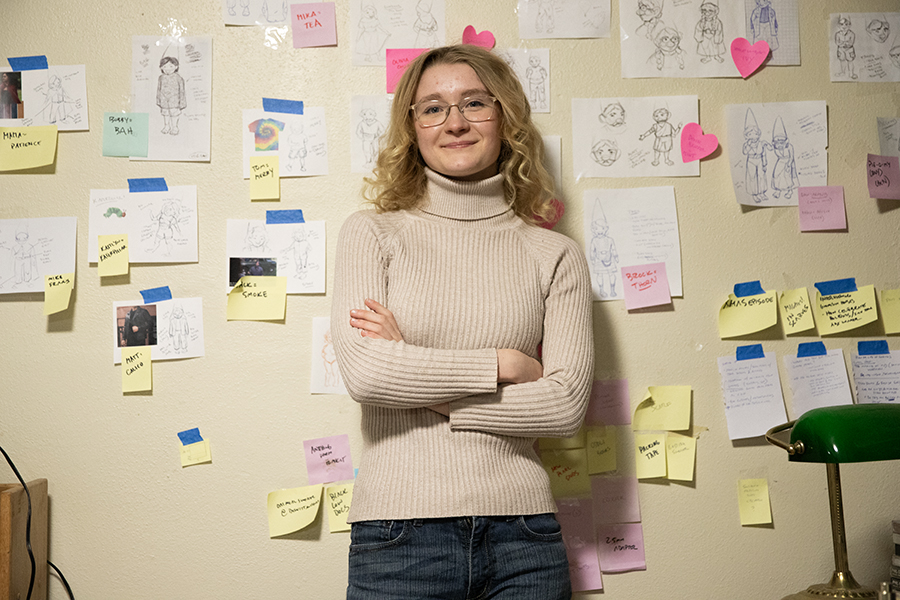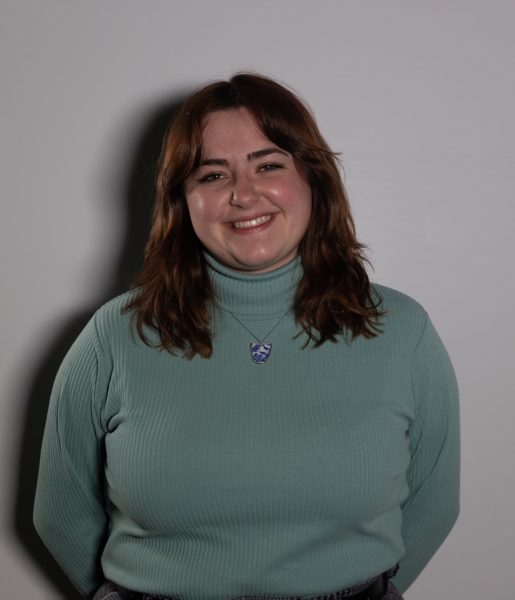Violet Van Buren, a senior at Ithaca College, has been creating an animated shorts series, titled “Gnome Homes.” The series involves interviews with her friends, with the occasional themed episode for a specific topic. The gnomes are often doing daily tasks in these shorts, such as hanging up laundry or walking through a forest, both showing the scale of these little creatures but also creating a comfortable visual not tied to the dialogue.
Co-Life and Culture Editor Molly Fitzsimons spoke with Van Buren about “Gnome Homes,” the process of creating episodes and how the visuals and other elements come together.
This interview has been edited for length and clarity.
Molly Fitzsimons: So why did you decide to begin this project?
Violet Van Buren: It started while I was in LA, I had an internship at Channel 101. They give you enough time to make your own short — if you want to make your own short. They’re a monthly film festival and every short has to be under five minutes. And usually it’s half animation and half real life stuff that they get submissions for. And I’ve been wanting to animate for a while. I’ve had an animation minor and didn’t have any reason to do it until I was in LA, so I was like, “Alright, maybe I’ll just make something for them.” Just get something out there. And then, you know, I’ve been doing it ever since, because the way it works is if you get voted in and you basically keep making shows once a month for them if you keep getting voted by the viewers who watch. They get, I don’t know, 100 to 200 viewers. A lot of them are on Twitch and then a lot of them are in person, and people vote on 10 shows and the best five get to return for the next month.
MF: What does the process of creating these episodes look like for you?
VB: Usually the first half of the month is making sure I have people to help me, people who will do an interview or people who will make music, right? The skills that I don’t have I collect for the first half of the month or just get more people included on the project. The second half of the month is usually getting the backgrounds done and the animation done. Then the last five days or so is dedicated crunch time. It’s making sure that it is good enough to put on for the screening that month.
MF: How do you decide who is voicing the gnomes or who you’re interviewing for those projects?
VB: Usually it’s just my friends. Although for some episodes, it’s definitely people who I know would have answers for it. I did an episode about what you see in your partner or how you enjoy being with people, and so I interviewed mostly couples for that episode and then I had a little bonus one about New Jersey and I had people who lived in New Jersey do those. Some of it is scouting, but most of it is just people I already know.
MF: Often the gnomes are talking about personal topics and their experiences while participating in unrelated tasks, such as laundry or just walking around. Why do you choose to have them at stills in their lives rather than just sitting and talking?
VB: I’m very inspired by creature comforts. If you know that, it’s the same guy who did “Wallace and Gromit.” He did [something] sort of similar, would interview the British public and then animated over them with these cute little animals who would do the talking. And I feel watching that at a young age and wanting to do something on my own — I’m just very inspired to show people who enjoy the comforts of everyday life. I think that is what I want to make more [of] in the future. I really enjoy media that is just comfortable and pleasant, you know, rather than necessarily controversial. I feel nowadays everything is controversial. So it’s nice to have something comforting, especially for adult entertainment.
MF: Do you find that the dialogue and the art are separate?
VB: I am using the animation almost as a proof of concept for maybe future animated shows, right? Just getting into that sort of fantasy comforting world and having them do actions that I couldn’t have them do in real life anyway. If all my interviews are just people sitting and talking already, why not have some motion associated with it?
MF: How is the process of animating a song and instrumental different from just speech?
VB: You definitely have to time it up with the song. The first half of that month was definitely making sure that the song was the right beats per minute and figuring out if it’s in 4/4, having it sort of grounded that way, so that I can lay out the frames the right way. So it is a little different. The hard thing is, with animation, you don’t want to do more work than you need to because it’s so labor intensive. To get it timed right along with a piece of music, you really have to put more effort into the mathematical side of it.
MF: How do you decide what will be the background?
VB: As the episodes go on, I wanted to change seasons as I was going. So when I started I think the first episode came out, end of March. So those were all in the spring, and then I did a lot of episodes over the summer so the seasons would change. As I was interviewing people and now, we’re in the fall. And then I think my last episode is going to be a Christmas episode or a holiday special, winter themed.
MF: What has been the biggest challenge while you’ve been working on these shorts?
VB: Definitely the time constraint, it’s the hardest thing. Making an animated piece that is roughly five minutes every month. Getting to the end of that month is such a hurdle and it’s not even for lack of ideas that I have. It’s solely the end result is not as good as I really want it to be because there’s never enough time to put into it. So, I think next year, I’ll probably not continue with Channel 101. I love them. They’re great, but it is so hard to get something so large out once a month, it was easier over the summer. But now, you know, I’m also a full-time student. So, working on an animated piece, four hours a night, while also having homework is just impossible.
MF: On your Instagram and TikTok page, there are other types of art, such as claymation, is there a favorite medium of art that you have? Is it the medium of the gnome homes shorts?
VB: I mean it’s easiest for me to do and it’s something that I’ve learned the most just in classes with Professor Harrington [associate professor in the Department of Media Arts, Sciences and Studies], a lot of the finals are usually 2D animation. So that’s what I’m best at. So that’s what it ended up being, but I would love to experiment with more given the chance, hopefully next year with more time. I’m taking Virtual Production next year, which I’m super excited about. It’s all the 3D, but I’ve never done any 3D before.
MF: Do you have an end goal with these “Gnome Home” shorts?
VB: I think it’s just to have something uniform that I can present to people in the future, a portfolio of work that exists so that I can get a job in an animation field, hopefully. But I guess the nicer thing to say would be like, “Oh, I want to, you know, inspire people to also learn to animate and take up the animation minor at Ithaca,” but also, it’s not so hard if you put a lot of work into it.
MF: Is there anything you would like to add without a prompted question?
VB: Support small film festivals. I’ve gotten a lot out of applying myself at Channel 101, but just in general, once I started there especially for Parkies, people will notice your work there and then you’ll get other stuff all over the place. I got some guy from the Connecticut Public Radio, who was like, “Hey, I saw your stuff and we’d love to interview you over the radio,” just some random dude, right? So wholesome. And that is what I would say. I feel a lot of Parkies stick to Park, and I think some of them do enter on FilmFreeWay, just entering competitions as many as you can. It’ll get your work noticed if nothing else.















